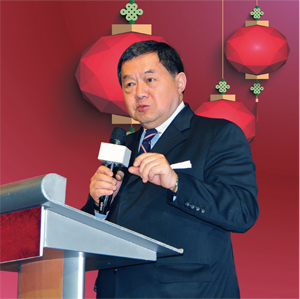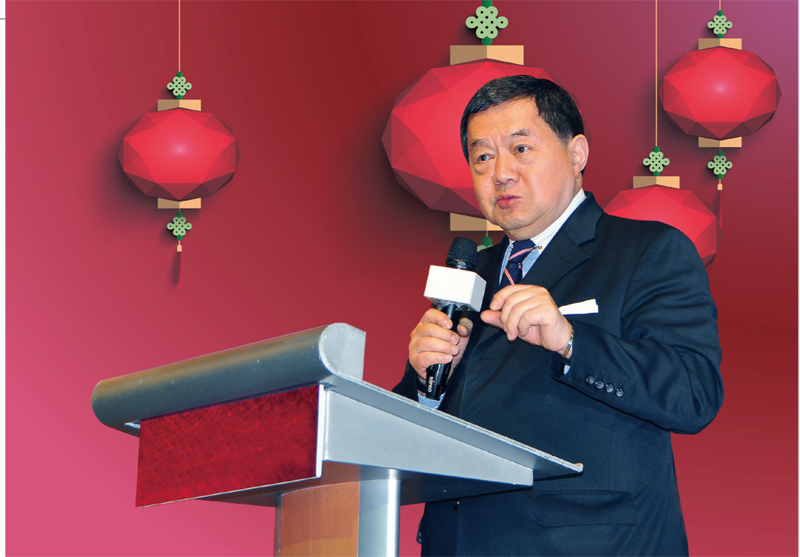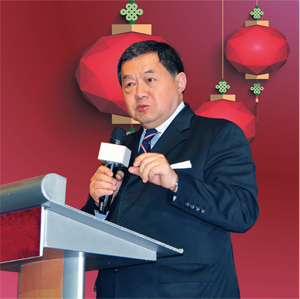2018年03月號 領航者的話
Chairman Douglas Hsu’s Address at the Far Eastern New Century Corporation Yearend Dinner
Far Eastern Group / Chairman Douglas Hsu


It is quite challenging to achieve an excellent performance in 4Q 2017 after the slow recovery from the economic downturn of 2016. Thank you all for the joint efforts. Looking into 2018, while seeing some twilight in the economy, we still need to be responsive and adaptive to changes in the world dynamics.
Far Eastern has been cooperating recently with two world renowned enterprises Amazon and Microsoft. AWS of Amazon, the cloud computing service of the powerful global e-commerce operator, chose to station its post at the Far Eastern Tpark in New Taipei City. Instead of direct investments, the advanced technologies and cloud computing resources brought by AWS are worth learning from. In other words, we will introduce the future technologies to Taiwan.
As to Microsoft, it is a multinational technology company. Despite its ample business scope, yet facing with fierce competitions from Facebook, Google and Amazon, there is no room for slackening. With a diverse service sector of the Far Eastern Group which encompasses retail, banking, and telecommunications, coupled with manufacturing businesses, as well as educational and medical institutions, Microsoft has signed off agreements with us to further expand its applications on various channels. Thus, Microsoft, as the leader in its field, has sensed a sense of urgency to transform. Meanwhile, Far Eastern should also expedite our transformation across horizons and move forward whilst maximize our internal and external resources in order to stride into the new century.
Before this, we should understand the three-major global trending which includes the rapid evolving technologies, intensive global competitions, and catastrophic extreme weather. These three forces are actually intertwined; the advancements of technologies has significantly elevated the big data storage and cloud computing capabilities, the increasing digitization has intensified the global competitions, and even exacerbated competitions from disruptive innovations. Meanwhile, the over consumption of natural resources has caused extreme weather. To achieve sustainability, we need not only to be more environmental conscious, but also need to continue to focus on innovation, transformation, and restructuring in management.
Last year at the Far Eastern Group’s Annual Summit, “Innovation”, “Transformation”, and “Restructure” are the Group’s future focal points. Hope you may understand more deeply and be more proactive.
I、Innovation:Refine Business Model
Since the first introduction of the steam-powered automobile in 1769, to the first gasoline vehicle in 1886, until the hybrid electric model developed in 1997, self-driving vehicles in 2009, battery-powered electrical autos in 2010……. The history of automobiles during the past 100 plus years proved that the only thing constant is “change.” Therefore, “Innovation” cannot be in a flash, but must march to progress constantly.
Furthermore, in the age of IoT, not only the home appliances must be inter-connected, individuals should also be closely connected with the outside world. The Group affiliates must strengthen horizontal connections in order to enhance synergies. And the immense data from IoT proves to be even more critical in terms of data analytics in technology capabilities, speed, logic setting and accuracies. All these are testing the management team’s capabilities to refine their business models. For example, based on past data the Group’s retail sector can evaluate customers’ spending habit to predict customer preferences, plan marketing strategies, and etc. Additionally, the health care sector can also analyze the admission and discharge records, doctors’ treatment processes to ensure more efficient operations in the future. In summary, our long-term competitive advantages relies on the abilities to create innovative business models. In order to create an innovative business model, we must possess the following four capabilities:
1. Analyze: Each department should clarify its current position in terms of existing ecosystems which comprises supply chains, competitors, technology advancements, and major trends.
2. Evaluate: Referring to the methods of homogeneous or heterogeneous industries, explore how to apply different models, rethink, and rebuild categories.
3. Adjust: Coordinate activities with internal and external stakeholders, integrate business model to achieve optimization.
4. Execute: Conduct small-scale testing, adjust and optimize accordingly.
II、transformation:Application of Artificial Intelligence
From the first industrial revolution in the 18th century, steam-based machines has replaced manual labor; then the second industrial revolution during the 19th~20th centuries, we entered into electrical energy-based mass production; proceeded to the third industrial revolution which was also the first launch of computer and internet; followed by the speedy developments of artificial intelligence, big data, IoT, and cloud computing to kick off the fourth industrial revolution which is also the second information revolution . In other words, by owning all these new knowledge, one may own the power to control the future.
In particular, artificial intelligence (AI) will change the future business model drastically. Analysts asserted that after five years, jobs such as financial advisors will very probably be replaced by AI. On the other hand, the world is changing tremendously that all information must be uploaded to the cloud for maximum application, not merely saved in personal computers. Moreover, every government is actively developing the 5G telecommunications, with which of course Taiwan’s telecom operators must also join. In summary, we all need to make more efforts in enhancing the power of AI and IT.
III、restructure:Break down the Silo Effect
In recent years, many institutions have been exploring how to respond to the changes, and to restructure their organizations. Not only structure needs to change, operating efficiencies should also elevate, cost benefit analysis should also be re-assessed, but most importantly, we must break down the silo effect.
Each business unit used to operate independently, and controlled their own costs and profits. In the world of IoT, retailers must connect deeply with the financial and telecom sectors to provide mobile payments to consumers to ensure smooth operations. This poses a tremendous challenge to us. Without collaborations across business units, there will be insufficient information exchanges, inefficient distribution of resources, innovative deficiencies, and lack of organizational coherence, all will hinder our efforts to seize market opportunities. Therefore, I would urge everyone to break the barriers and fortify horizontal connections.
Create the Next Growth Curve for the Group
Upon launching new products, usually the enterprise valuation will grow upward. However, the growth curve will flatten gradually along with time, and eventually goes downturn. In order to achieve sustainable growth, we must create the second and even the third growth curves before the first one reaches its peak. Thus, the businesses can continue to grow, and staffs can prolong their career planning. We need to constantly innovate, transform, and restructure to achieve these growth curves. On the wave front of intellectual transformation, whether we are able to create a new business model with the application of AI, big data, IoT, and cloud technologies, all depends on your dedication to creating the next growth curve and continue the Group’s leading position in the next six decades!#



















